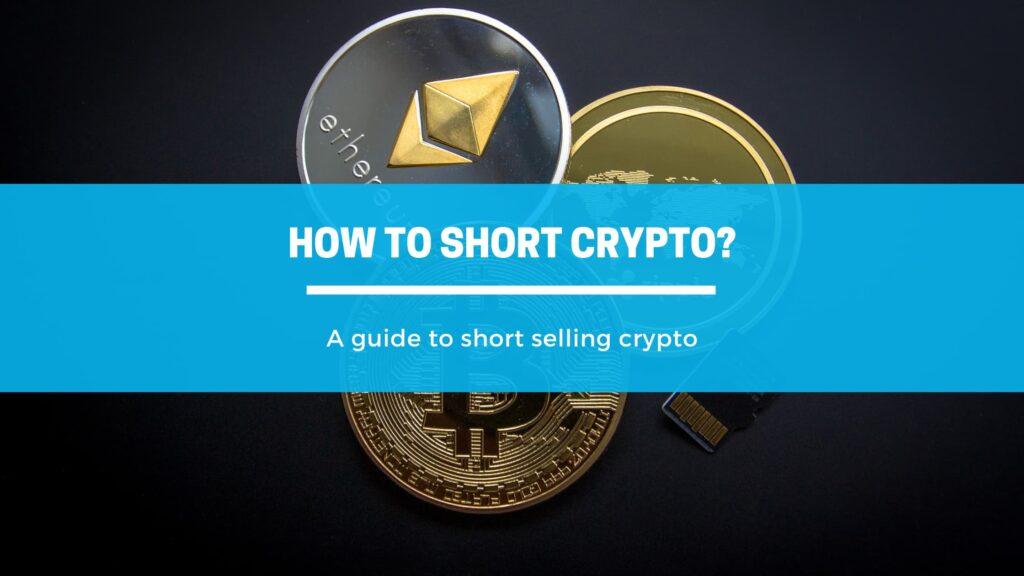Cryptocurrency has become a buzzword in the financial world and has become a popular investment option for people looking to diversify their portfolios. However, despite its growing popularity, cryptocurrency can be quite volatile and is often subject to large price swings.
In such a scenario, it may not always be an attractive option for those looking to invest their money in a secure manner.
This is where short selling crypto comes in. Shorting crypto is a trading strategy that involves borrowing cryptocurrency and selling it, with the hope of buying it back at a lower price, profiting from the difference.
This blog post will discuss the basics of shorting crypto and how you can get started with it.
Shorting Crypto: At a Glance
Shorting crypto is a way of taking advantage of the price fluctuations in the cryptocurrency market. It is a strategy that involves borrowing cryptocurrency from a broker and selling it in the market, with the hope of buying it back at a lower price.
For example, let's say you believe that the price of Bitcoin is going to fall in the near future. You could borrow Bitcoin from a broker, sell it at its current market price, and then wait for the price to fall. Once the price drops, you can buy back the same amount of Bitcoin that you sold, and return it to the broker. The difference between the price you sold the Bitcoin at and the price you bought it back is your profit.
Why Short Crypto?
There are several reasons why someone might want to short crypto. Some of the most common reasons include:
- Profit from price declines: One of the main benefits of shorting crypto is that it allows traders to profit from price declines in the market. If a trader believes that the price of a certain cryptocurrency is going to decrease, they can open a short position and make a profit as the price falls.
For instance, if a trader believes that the price of Bitcoin is going to drop, they can open a short position by borrowing Bitcoin from a broker and selling it on the market. If the price of Bitcoin does indeed fall, the trader can buy back the same amount of Bitcoin at the lower price, return it to the broker, and keep the profit.
- Diversify investment portfolio: Shorting crypto can also be a way to diversify an investment portfolio. By shorting crypto, traders can balance their portfolio and potentially reduce their overall risk, as they can profit from both rising and falling prices.
- Hedge against market volatility: Shorting crypto can also be used as a way to hedge against market volatility. By shorting crypto, traders can potentially reduce the impact of market volatility on their portfolio.
If a trader is holding a long position in a certain cryptocurrency and the market becomes volatile, they can open a short position in a different cryptocurrency as a way to hedge their position. If the price of the cryptocurrency in their long position falls, the trader can make a profit on their short position, potentially offsetting the loss on their long position.
It is important to note that shorting crypto is a high-risk strategy and requires a good understanding of the market and the ability to make quick decisions. It is not suitable for all investors and traders. You should only invest money that they can afford to lose.
Here's a comparison table comparing the different types of ways to short cryptocurrencies:
| Method | Definition | Pros | Cons |
| Short Selling | Involves borrowing a cryptocurrency from a broker and selling it, with the expectation that its price will fall. The trader then buys back the cryptocurrency to repay the borrowed amount, profiting from the price difference. | Potential for profits if the price of the cryptocurrency fallsOpportunity to profit from market downturns | Risk of incurring unlimited losses if the price of the cryptocurrency risesPotential for high costs, such as borrowing fees and interest on the loan |
| Futures Contracts | Involves buying or selling a contract that obligates the trader to buy or sell a specific cryptocurrency at a specific price and date in the future. | Opportunity to profit from both rising and falling pricesAbility to use leverage to increase the size of the trade | Complexity of understanding and using futures contracts |
| Options Trading | Involves buying or selling options contracts that give the trader the right, but not the obligation, to buy or sell a specific cryptocurrency at a specific price and date in the future. | Flexibility to choose between buying a call option (long) or a put option (short) | Potential for large losses if the option expires |
How to Short Crypto: Step-by-step
Now that we have a basic understanding of what shorting crypto is and why someone might want to do it, let's discuss how to get started with it.
Choose a Crypto Broker
The first step in shorting crypto is to choose a cryptocurrency broker. A broker facilitates the buying and selling of cryptocurrencies. When shorting crypto, you need to find a broker that allows you to borrow cryptocurrency and sell it in the market.
There are several cryptocurrency brokers that offer shorting services, including BitMex, Kraken, and Binance. It is important to choose a broker that is reputable and regulated, as this will ensure that your funds are safe.
Open an Account
Once you have chosen a broker, the next step is to open an account. This typically involves providing some basic personal information and completing the account verification process. Once your account is open, you will need to deposit funds into it, which you will use to trade cryptocurrency.
Place a Short Order
Once your account is set up and funded, you are ready to place a short order. This involves borrowing cryptocurrency from the broker and selling it in the market. To place a short order, you will need to select the cryptocurrency you want to short and specify the amount. You will also need to set the price at which you want to sell the cryptocurrency, which is typically the current market price.
It is important to keep in mind that shorting crypto involves borrowing cryptocurrency, which means you will be charged interest on the borrowed amount. This is known as the “borrow rate” and can vary depending on the broker and the cryptocurrency you are shorting.
Monitor the Market
Once you have placed your short order, it is important to monitor the market and be prepared to act quickly if the price of the cryptocurrency moves against your position. If the price of the cryptocurrency increases, your short position will start to lose value, and you will need to decide whether to buy back the cryptocurrency and close your position, or hold on and hope for a price decline.
Close Your Position
When you are ready to close your short position, you will need to buy back the same amount of cryptocurrency that you borrowed and sold. This will allow you to return the cryptocurrency to the broker and close your position. The difference between the price you sold the cryptocurrency at and the price you bought it back is your profit or loss.
Important Terminologies
| Short Position | A short position is a bet that the price of a cryptocurrency will fall. In a short position, the trader borrows cryptocurrency from a broker and sells it on the market, with the aim of buying it back at a lower price to make a profit. |
| Borrow Rate | The borrow rate is the interest that is charged on the borrowed cryptocurrency. It can vary depending on the broker and the cryptocurrency being shorted. |
| Market Price | The market price is the current price of a cryptocurrency. It is the price at which a trader can buy or sell a cryptocurrency on the market. |
| Profit/Loss | The difference between the price at which a trader sells a cryptocurrency and the price at which they buy it back is their profit or loss. |
| Limit Order | A limit order is an order to buy or sell a cryptocurrency at a specific price or better. In the context of shorting crypto, a limit order can be used to set the price at which the trader wants to close their short position. |
| Margin Trading | Margin trading is the practice of borrowing funds from a broker to trade financial instruments, including cryptocurrencies. In the context of crypto shorting, margin trading can be used to increase the size of the short position and potentially increase the profit. |
| Stop-Loss Order | A stop-loss order is an order that automatically closes a position when the price of a cryptocurrency reaches a certain level. In the context of shorting crypto, a stop-loss order can be used to limit losses in case the price of the cryptocurrency increases. |
Bonus: Contract for Difference (CFD)
CFDs can be used to capitalize on the price movements of cryptocurrencies.
With a CFD, the trader enters into an agreement with a broker to pay the difference between the opening price and the closing price of the contract. If the price of the cryptocurrency falls, the trader makes a profit, and if the price of the cryptocurrency rises, the trader incurs a loss.
CFDs are popular in the cryptocurrency market because they offer several advantages over traditional short selling. For example, CFDs are typically more accessible to smaller traders, as they do not require the trader to have access to the underlying cryptocurrency. They also allow traders to use leverage, which can increase potential profits and losses.
However, CFDs are also associated with risks.
For example, CFDs are typically more expensive than traditional short selling, as the broker charges a spread on each trade. They also carry a higher risk of loss, as the trader must pay the difference between the opening and closing price, regardless of the size of the price movement.
Additional Tips
Here are some tips to maximize your chances of success when shorting cryptocurrencies:
- Conduct thorough research: Before shorting any cryptocurrency, it is important to conduct thorough research on the market, the cryptocurrency, and its potential for price movement. This includes understanding the current economic and political conditions, the supply and demand of the cryptocurrency, and its technical and fundamental analysis.
- Choose a reputable broker: It is important to choose a reputable broker that offers reliable trading platforms and tools, low fees, and a secure trading environment. Additionally, it is important to make sure the broker is regulated and that your funds are protected in case the broker becomes insolvent.
- Use a stop-loss order: A stop-loss order can be used to limit potential losses in case the price of the cryptocurrency moves against your position. This can help you manage risk and protect your capital.
- Diversify your portfolio: Diversifying your portfolio can help you manage risk and reduce the impact of any losses. By spreading your investments across a range of different cryptocurrencies, you can reduce your exposure to any one particular cryptocurrency.
- Keep a close eye on the market: The cryptocurrency market can be volatile and prices can move quickly. It is important to keep a close eye on the market and be prepared to make quick decisions in response to changing market conditions.
- Use margin trading: Margin trading can be used to increase the size of your short position and potentially increase your profit. However, it is important to use margin trading responsibly, as it also increases the risk of losses.
- Stay disciplined: Staying disciplined and sticking to your strategy can help you avoid making emotional decisions and potentially losing money. It is important to have a well-defined trading plan and stick to it, even in the face of market volatility.
By following these tips and using a combination of technical and fundamental analysis, traders can increase their chances of success when shorting cryptocurrencies.
Conclusion
Shorting crypto can be a lucrative way of taking advantage of the price fluctuations in the cryptocurrency market. Before getting started with shorting crypto, it is essential to do your research, choose a reputable broker, and familiarize yourself with the risks involved. As with any investment, it is important only to invest money that you can afford to lose.
In conclusion, shorting crypto can be a valuable addition to your investment portfolio, but it should be approached with caution and a thorough understanding of the market.




